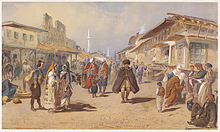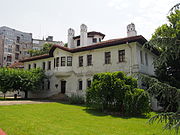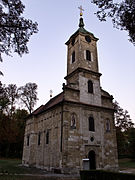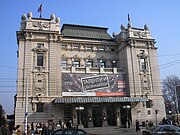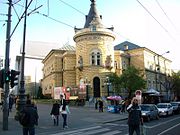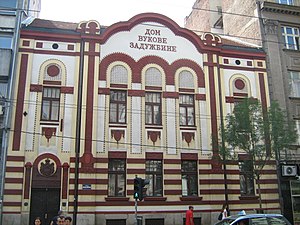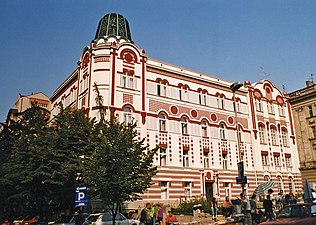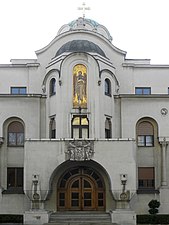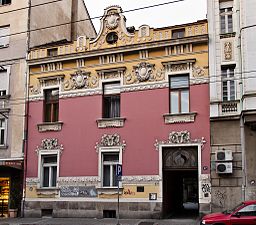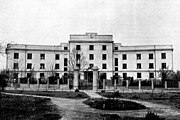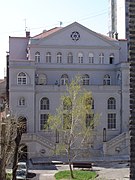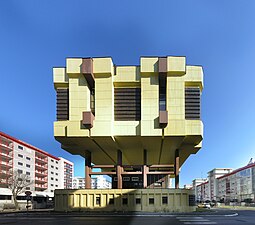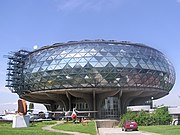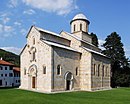Brutalist architecture is an architectural style that emerged during the 1950s in the United Kingdom, among the reconstruction projects of the post-war era. Brutalist buildings are characterised by minimalist constructions that showcase the bare building materials and structural elements over decorative design. The style commonly makes use of exposed, unpainted concrete or brick, angular geometric shapes and a predominantly monochrome colour palette; other materials, such as steel, timber, and glass, are also featured.

The Church of Saint Sava is a Serbian Orthodox church which sits on the Vračar plateau in Belgrade, Serbia. It was planned as the bishopric seat and main cathedral of the Serbian Orthodox Church. The church is dedicated to Saint Sava, the founder of the Serbian Orthodox Church and an important figure in medieval Serbia. It is built on the presumed location of St. Sava's grave. His coffin had been moved from Mileševa Monastery to Belgrade. The coffin was placed on a pyre and burnt in 1595 by Ottoman Grand Vizier Sinan Pasha. Bogdan Nestorović and Aleksandar Deroko were finally chosen to be the architects in 1932 after a second revised competition in 1926–27. This sudden decision instigated an important debate in interwar Yugoslavia which centered around the temple's size, design and symbolic national function. This was accompanied by a sizeable increase in the base area of the ambitiously conceived project. The new design departed from the competition guidelines issued in 1926, and was to replicate the dimensions and architecture of Hagia Sophia.
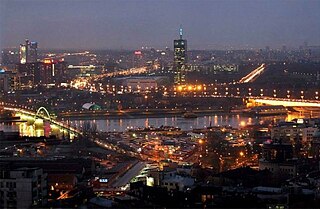
New Belgrade is a municipality of the city of Belgrade. It was a planned city and now is the central business district of Serbia and South East Europe. Construction began in 1948 in a previously uninhabited area on the left bank of the Sava river, opposite old Belgrade. In recent years, it has become the central business district of Belgrade and its fastest developing area, with many businesses moving to the new part of the city, due to more modern infrastructure and larger available space. With 209,763 inhabitants, it is the second most populous municipality of Serbia after Novi Sad.

Neo-Byzantine architecture was a revival movement, most frequently seen in religious, institutional and public buildings. It incorporates elements of the Byzantine style associated with Eastern and Orthodox Christian architecture dating from the 5th through 11th centuries, notably that of Constantinople and the Exarchate of Ravenna.

Vračar plateau is a plateau on top of the Vračar Hill in Belgrade, the capital of Serbia. with an absolute height of 134 metres above sea level. It is the purported location of the 1594 Burning of Saint Sava's relics by the Ottomans. The dominant position in Belgrade's cityscape made the plateau a natural location for the first meteorological observatory in Serbia, Belgrade Meteorological Station, built in 1891. The most distinctive feature of the plateau today is a massive Church of Saint Sava, visible from almost all approaches to the city, and one of the Belgrade's main landmarks. The plateau also houses Karađorđe's Park, Park Milutin Milanković, monument of Karađorđe Petrović and National Library of Serbia.
The architecture of Bosnia and Herzegovina is largely influenced by four major periods, when political and social changes determined the creation of distinct cultural and architectural habits of the region.
Milan Zloković was a Serbian architect. His works epitomised two epochs of architecture in Belgrade.

Neimar is an urban neighborhood of Belgrade, Serbia. It is located in Belgrade's municipality of Vračar.
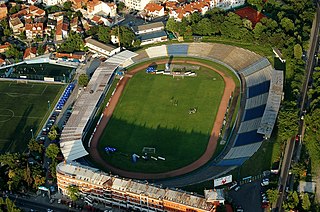
Bogoslovija is an urban neighborhood of Belgrade, the capital of Serbia. It is mostly located in Belgrade's municipality of Palilula, with some parts belonging to the municipality of Zvezdara.

The architecture of Serbia has a long, rich and diverse history. Some of the major European style from Roman to Postmodern are demonstrated, including renowned examples of Raška, Serbo-Byzantine with its revival, Morava, Baroque, Classical and Modern architecture, with prime examples in Brutalism and Streamline Moderne.

The groups of people who have settled or controlled the territory of modern-day North Macedonia have influenced the country in many ways, one of the most visible being architecture. These groups of people include the Paionians, Illyrians, Ancient Macedonians, Romans, Byzantines, Bulgarians, Serbs, Ottomans, Yugoslavs, and ethnic Macedonians.

The Palace of Serbia is a building located in the Novi Beograd municipality of Belgrade, Serbia. The building is used by the government of Serbia and currently houses several cabinet level ministries and agencies.
The architecture of Kosovo dates back to the Neolithic period and includes the Copper, Bronze and Iron Ages, Antiquity and the Medieval period. It has been influenced by the presence of different civilizations and religions as evidenced by the structures which have survived to this day. Local builders have combined building techniques of conquering empires with the materials at hand and the existing conditions to develop their own varieties of dwellings.

The Modern Serbo-Byzantine architectural style, Neo-Byzantine architectural style or Serbian national architectural style is the style in Serbian architecture which lasted from the second half of the 19th century to the first half of the 20th century. This style originated in the tradition of medieval Serbian-Byzantine school and was part of international Neo-Byzantine style.

The Ministry of Finance of Serbia Building is a building of the Ministry of Finance of Serbia, located in Savski Venac, Belgrade, Serbia.

The Building of the Patriarchate is a building in Belgrade, the capital of Serbia. It is the administrative seat of the Serbian Orthodox Church and its head, the Patriarch of the Serbian Orthodox Church. Finished in 1935, the building was declared a cultural monument on 18 December 1984.
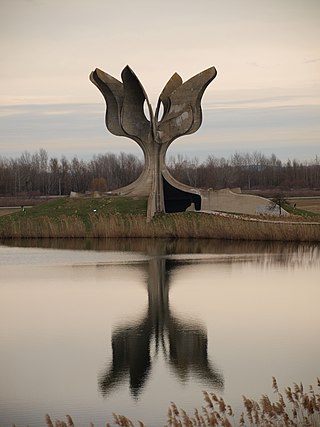
The architecture of Yugoslavia was characterized by emerging, unique, and often differing national and regional narratives. As a socialist state remaining free from the Iron Curtain, Yugoslavia adopted a hybrid identity that combined the architectural, cultural, and political leanings of both Western liberal democracy and Soviet communism.
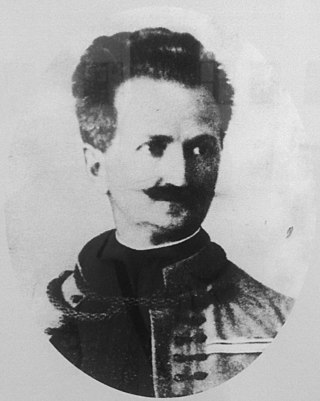
Momir Korunović, was a Serbian architect best-known for his projects built in Serbo-Byzantine Revival. He was sometimes called the Serbian Gaudi. Although he designed some of the most beautiful buildings in Belgrade and was the leading architect of sacred buildings in Yugoslavia between the two world wars, today he is insufficiently known to the general public. Many of his works were destroyed or substantially altered during World War II and the period of communist dictatorship.

